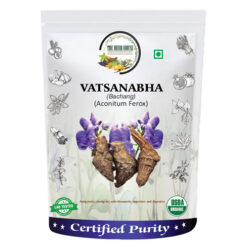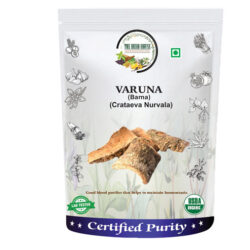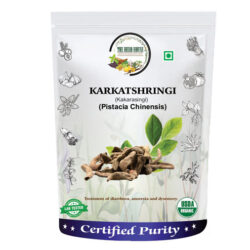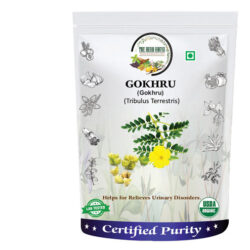Description
Yavasa (Alhagi camelorum) is a perennial plant which originates from massive rhizome system and extend up to sex feet into ground. Now shoots can appear around 200 feet from parent plant. Whereas above the ground plant hardly reaches four feet in height. It is heavily branched along with the gray green, long spines on branches. It bears the small, bright pink to maroon pea color flowers. It contains the small legume pods which are brown or reddish and constricted between the seeds. The seeds are spotted brown beans.
Types Of Yavasa (Alhagi Camelorum)
THIS HERBS HAS THE 5 TYPES WHICH ARE MENTIONED BELOW:-
- Alhagi camelorum
- Alhagi persarum
- Alhagi pseudalhagi
- Hedysorum pseudalhagi
- Alhagi mauroru
ACCORDING TO SODHALA NIGHANTU, 2 VARIETIES OF THE PLANT YAVASA ARE:-
- Dhanvayasa
- Yasa
General Information
This herb has the great medicinal importance in Ayurveda due to its therapeutic properties. It is loaded with aphrodisiac, antipyretic, laxative, diuretic blood purification and diuretic properties.
This herb helps to remove the excess of fat, manages the brain health issues, treat the respiratory complications. Use of this herb is also good to cure the piles. Its medicinal properties also help top cure various other complications like hemicranias, leprosy and opacity of cornea.
There are various phytochemical compounds are present in different parts of herbs. Twigs contain the B – Phenethylamine, N – Methyl – B – Phenethylamine, N – Methyl tyramine, Hordmine, 3,4 – Dihydroxy – B – phenethyl – trimethyl ammonium hydrozide., 3 methoxy – 4 – hydrozyl – B Phenethyl trimethyl ammonium hydroxide, N – methyl mescaline, Salsolidine and have small quantity of choline & Betaline. Whereas Roots and stem of this herb contain the Alkaloid and phytosterols. All the above explained phytochemical compounds are packed with the healing properties and helps to cure various ailments in a natural way.
Classification
- Kingdom – Plantae (Plants)
- Sub Kingdom – Tracheobionta (Vascular Plants)
- Super Division – Spermatophyta (Seed Plants)
- Division – Magnoliopsida (Dicotyledons)
- Class – Magnoliopsida (Dicotyledons)
- Subclass – Rosidae
- Order – Fabales
- Family – Fabaceae (Pea Family)
- Genus – Alhagi
- Species – Camelorum
Habitat
This herb is globally distributed from Mediterranean and Sahara to central Asia. In India it is grown in Himalayas, Ganges valley, Kashmir, Punjab, Bihar, Rajasthan and Gujarat.
Ayurvedic Properties
| Hindi / Sanskrit | English | ||
| Rasa | Madhura, Tikta, Kashaya | Taste | Sweet, Bitter, Astringent |
| Guna | Laghu | Physical Property | Light |
| Virya | Sheeta | Potency | Cold |
| Vipaka | Katu | Metabolic Property (After Digestion) | Pungent |
Effects On Doshas
It balances pitta and kapha doshas.
Ayurvedic Classification Of Alhagi Camelorum
Charaka, Sushruta and Vagbhata has not classified the herb Yavasa in to any of the ganas or vargas. Whereas Nighantus have mentioned it under different vargas.
- Kula – Shimbi kula.
- Upakula – Aparajita upakula
- Dhanwantari Nighantu – Guduchyadi varga
- Bhavaprakasha Nighantu – Guducyhadi varga
- Raja Nighantu – Shatahvadi varga
- Kaiyadeva Nighantu – Oshadhi varga
- Shaligrama Nighantu – Ikshu varga
Practical Uses Of Alhagi Camelorum
- Anti-inflammatory properties of this herb are quite beneficial to reduce the pain in joint, legs, arms and different parts of the body.
- Use of this herb is quite good in the treatment of piles. It helps to improve the digestion and also resolves the problem of constipation which can be the cause of piles. Further it helps to provide relief in the symptoms of hemorrhoids/piles like irritation, itching, redness, soreness and swelling around anus.
- Juice from the leaves of this herb is used as nasal drop. This juice is very beneficial in headaches.
- Oil boiled with Yavasa is used for massage in rheumatoid arthritis. Anti-inflammatory properties of this oil help in pain reduction.
- Decoction of this herb is used for gargling in stomatitis. Thus decoction of this herb helps to reduce inflammation of the mucous membrane of the mouth. It also helps in healing of wounds and also prevents the pus formation.
- This herb is quite to manage the symptoms like syncope. Syncope is the condition in which there is temporary loss of consciousness due to the fall in blood pressure.
- This herb also supports the good health of digestive system. Hence it is good to resolve problems like indigestion, emesis, heartburn, dyspepsia and constipation.
- This herb is beneficial in the haemorrhagic disorders.
- This herb also good in the treatment of respiratory complications like common cold, cough, asthma and bronchitis. It helps to clear the airways and also enhance the body’s immunity to fight against the various viral or bacterial infections.
- This herb helps in the relaxation of muscles of neck. Hence it is useful in neck stiffness.
- It helps to increase the physical strength of body. Use of this herb is also good in weight gain.
- This is known to be an effective herb to manage the problem of vertigo. This herb helps to pacify the nervous system. Moreover this herb also helps to provide relief in the symptoms associated with vertigo like anxiety, stress, headache and brain complications.
Parts Used
Whole plant.
Dosage
Decoction: 40-80 ml.







Reviews
There are no reviews yet.